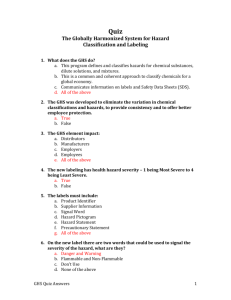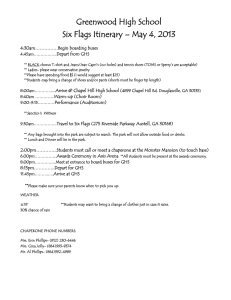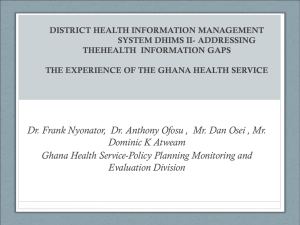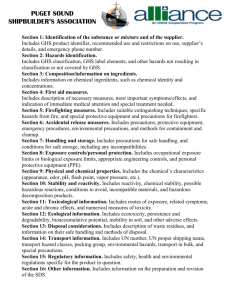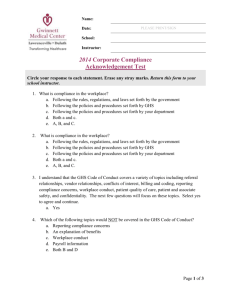United Nations
advertisement
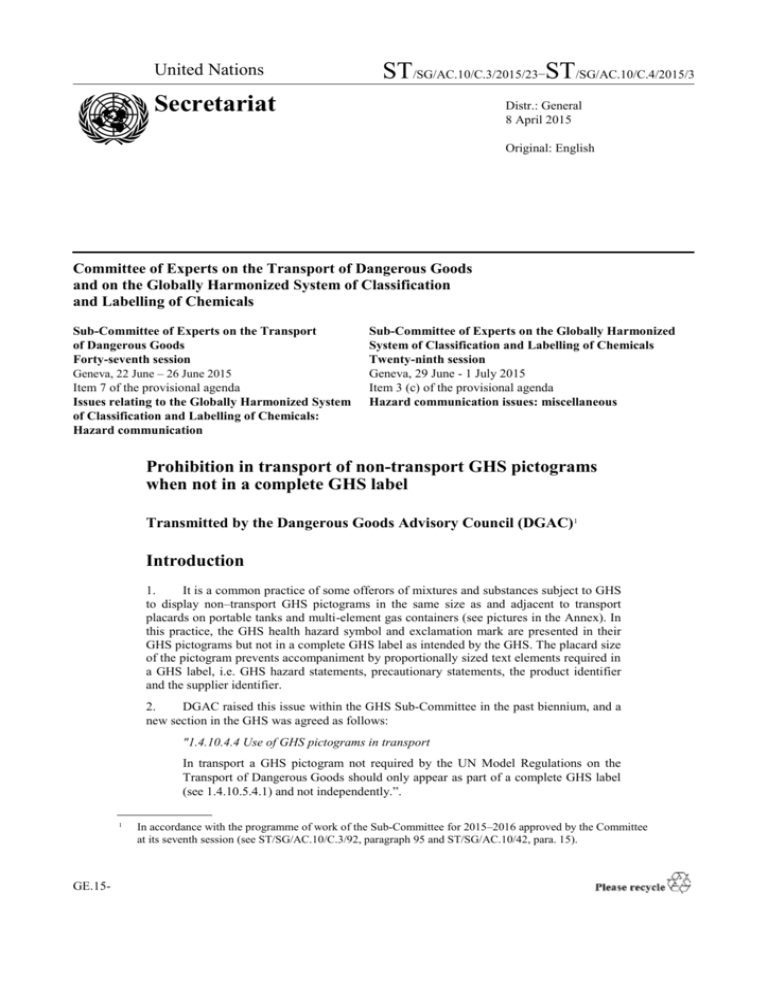
United Nations ST/SG/AC.10/C.3/2015/23−ST/SG/AC.10/C.4/2015/3 Secretariat Distr.: General 8 April 2015 Original: English Committee of Experts on the Transport of Dangerous Goods and on the Globally Harmonized System of Classification and Labelling of Chemicals Sub-Committee of Experts on the Transport of Dangerous Goods Forty-seventh session Geneva, 22 June – 26 June 2015 Item 7 of the provisional agenda Issues relating to the Globally Harmonized System of Classification and Labelling of Chemicals: Hazard communication Sub-Committee of Experts on the Globally Harmonized System of Classification and Labelling of Chemicals Twenty-ninth session Geneva, 29 June - 1 July 2015 Item 3 (c) of the provisional agenda Hazard communication issues: miscellaneous Prohibition in transport of non-transport GHS pictograms when not in a complete GHS label Transmitted by the Dangerous Goods Advisory Council (DGAC)1 Introduction 1. It is a common practice of some offerors of mixtures and substances subject to GHS to display non–transport GHS pictograms in the same size as and adjacent to transport placards on portable tanks and multi-element gas containers (see pictures in the Annex). In this practice, the GHS health hazard symbol and exclamation mark are presented in their GHS pictograms but not in a complete GHS label as intended by the GHS. The placard size of the pictogram prevents accompaniment by proportionally sized text elements required in a GHS label, i.e. GHS hazard statements, precautionary statements, the product identifier and the supplier identifier. 2. DGAC raised this issue within the GHS Sub-Committee in the past biennium, and a new section in the GHS was agreed as follows: "1.4.10.4.4 Use of GHS pictograms in transport In transport a GHS pictogram not required by the UN Model Regulations on the Transport of Dangerous Goods should only appear as part of a complete GHS label (see 1.4.10.5.4.1) and not independently.”. 1 GE.15- In accordance with the programme of work of the Sub-Committee for 2015–2016 approved by the Committee at its seventh session (see ST/SG/AC.10/C.3/92, paragraph 95 and ST/SG/AC.10/42, para. 15). ST/SG/AC.10/C.3/2015/23 ST/SG/AC.10/C.4/2015/3 3. The text “a GHS pictogram not required by the UN Model Regulations on the Transport of Dangerous Goods” refers to the GHS exclamation point and health hazard pictograms. GHS paragraph 1.4.10.5.4.1 states that the GHS label elements should be located together. While not directly referenced, GHS section 1.4.10.5.2 states that a complete GHS label must contain not only a pictogram, but also signal words, hazard statements, precautionary statements and product and supplier identification. Discussion 4. Similar to inconsistencies in transport of dangerous goods (TDG) regulations, inconsistencies in GHS implementation can cause delay and denial in the supply chain. Thus it is beneficial to maintain harmonization between the Model Regulations and the GHS to manage a consistent global transport system. The Model Regulations facilitate safe commerce based on biennial implementation by the International Maritime Organization, the International Civil Aviation Organization, and various regional and national regulations. To provide internationally enforceable requirements aligned with the intent of the GHS, DGAC proposes to mirror the new GHS requirement for transport in a complementary text in the Model Regulations. 5. It remains necessary and desirable to allow the use of GHS pictograms on portable tanks, but only as part of a complete and proportional GHS label. GHS guidance on size proportionality of the pictogram and text elements of a GHS label is found in the GHS Annex 7, Example 7, Paragraph (e): “The pictograms may be distinguished by adjusting their size. Generally speaking, the size of the non-transport pictograms should be proportional to the size of the text of the other label elements. This would generally be smaller than the transportrelated pictograms, but such size adjustments should not affect the clarity or comprehensibility of the non-transport pictograms;” 6. While studying the GHS and the Model Regulations hazard communication requirements, we identified that the inter-relationship of TDG and GHS hazard communication is not addressed in Part 5 of the Model Regulations. Therefore we propose a new section in Part 5 to address prohibited placarding. A definition of GHS label is also proposed. Proposal 7. Create a new section in the Model Regulations as follows: “5.3.1.X Prohibited placarding GHS pictograms are prohibited from appearing on cargo transport units, unless they appear as an element within a complete GHS label, of a size proportional to the text elements.” 8. Create a new definition of GHS label: “GHS Label - A GHS label means the group of elements required by the GHS in paragraph 1.4.10.5.2 and placed together as required by paragraph 1.4.10.5.4.1.” 2 ST/SG/AC.10/C.3/2015/23 ST/SG/AC.10/C.4/2015/3 Annex Examples of GHS pictograms appearing alone, not compliant with GHS paragraph 1.4.10.4.4 Example 1 Example 2 3 ST/SG/AC.10/C.3/2015/23 ST/SG/AC.10/C.4/2015/3 Example 3 4
